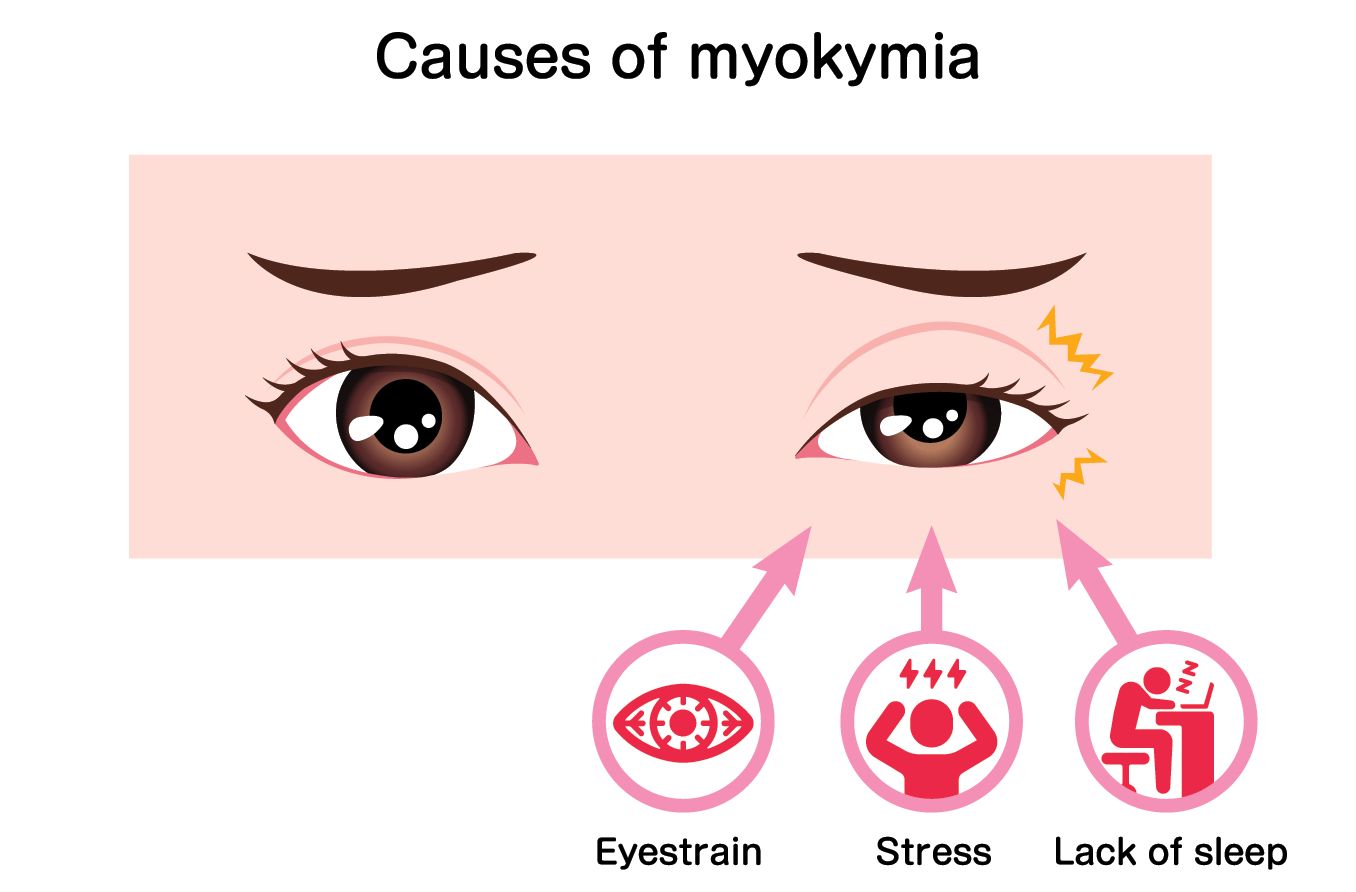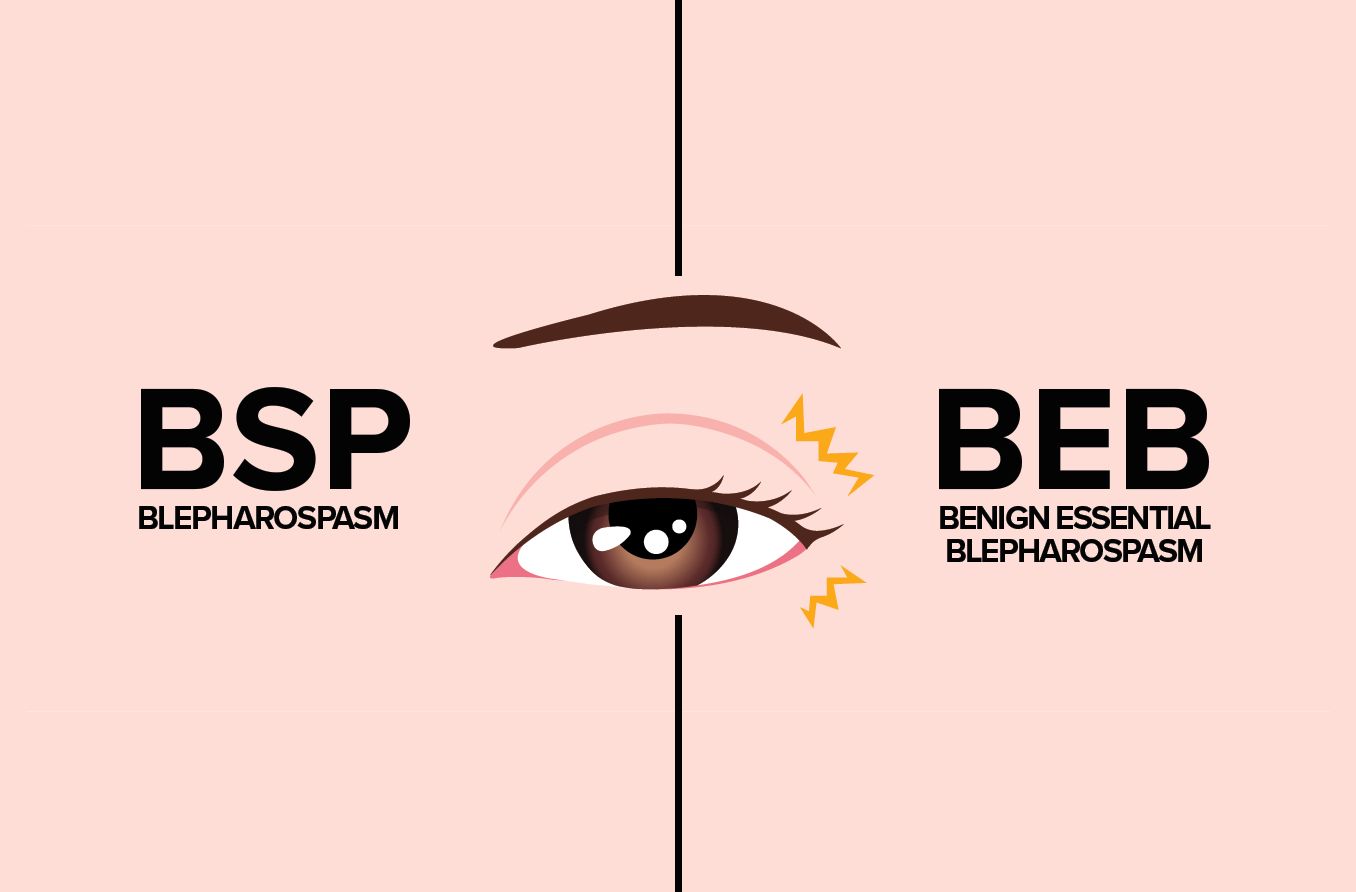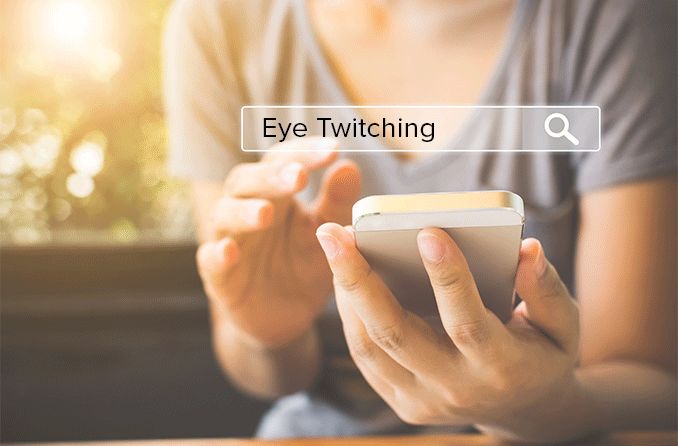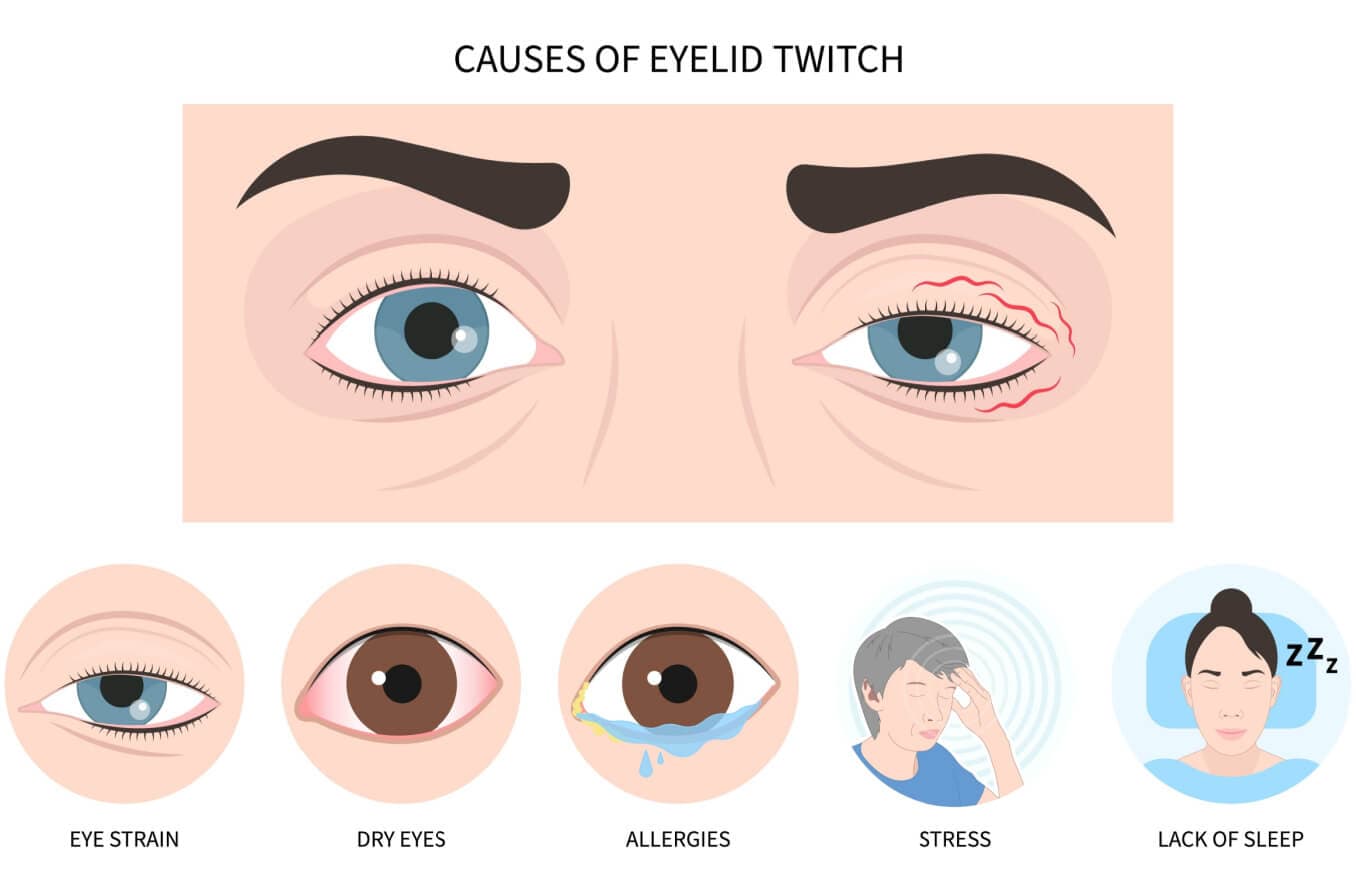What is myokymia?
Myokymia (pronounced mai-ow-KAI-mee-uh) is the medical term for eye twitching . It’s a common problem experienced by almost everyone at some point in their lives.
During myokymia, tiny involuntary contractions occur in a muscle of one eyelid . This looks like a “twitch” from the outside. Eyelid spasms usually happen in the lower eyelid, but they can happen in the upper eyelid too.
While eye spasms can be annoying, they’re almost never cause for concern. They can last anywhere from a few moments to several days and usually go away on their own. In rare situations, spasms can last for months or even longer.
Types of myokymia
Myokymia is often a twitchy eyelid. However, muscle twitching can happen just about anywhere on the body. The different types of myokymia affect various areas of the body.
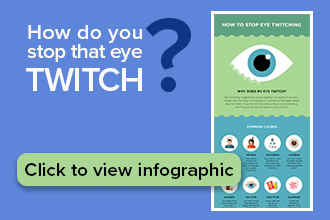
Generalized myokymia
Generalized myokymia is persistent muscle contractions throughout the body. The constant contractions often cause the muscles to cramp or twitch and become stiff or weak. Excessive sweating from the constant contractions may also be present.
Contractions occur because of abnormal electrical signals from motor nerves that stimulate the muscle. The twitchy muscles create a rippling effect beneath the skin, which is often compared to “a bag of worms.”
Generalized myokymia does not affect smooth muscle, which helps with involuntary actions like digestion. It also doesn’t affect the cardiac muscle that makes up the heart.
Cold temperatures can worsen symptoms. Muscle spasms often occur even when the muscles are resting and during sleep.
SEE RELATED: Eye twitching during pregnancy
Focal or segmental myokymia
Unlike generalized spasms that affect the entire body, focal or segmental myokymia targets a specific area. Common areas affected include the arms, legs and face.
Contractions of the targeted area are small, consistent and rhythmic. They produce the same rippling observed in generalized myokymia.
Facial myokymia
Facial myokymia is a type of focal myokymia that — as the name states — affects the muscles of the face. Cases can be bilateral (affecting both sides of the face) or unilateral (affecting only one side).
Affected areas include the cheeks, chin and around the mouth. The lower eyelids are usually affected too.
Muscle contractions make the affected area look like it’s pulsing in a wave-like motion. Contractions may start in one area and then move to another area of the face. It’s also possible for multiple areas of the face to “fire off” at the same time.
Facial myokymia vs. hemifacial spasm
It’s easy to confuse facial myokymia and hemifacial spasm because they’re very similar. However, there are some key differences between the two.
For one, they usually look different. Facial myokymia causes the facial muscles to spasm, which gives the rippling appearance beneath the skin. But the spasm usually isn’t strong enough to force facial movement, like squinting the eye or curling up the corners of the mouth. These types of movements are observed in hemifacial spasms.
Another difference is in what causes the twitching. Hemifacial spasm occurs when the facial nerve (CN VII) is compressed. The facial nerve controls the facial muscles to perform certain movements. When the nerve is compressed, the signals can get crossed, or sent involuntarily.
Facial myokymia is often caused by inflammatory diseases that damage the protective covering of nerve fibers in the brain. Lastly, hemifacial spasm gets its name because it usually affects only one side of the face. Facial myokymia can affect one or both sides.
SEE RELATED: Eyebrow twitching: Causes and treatment
Ocular myokymia (eyelid myokymia)
Ocular myokymia is what most people think of when they imagine a twitchy eye. It occurs when the muscle surrounding the eye (orbicularis oculi muscle) receives random motor signals from the facial nerve. This causes the muscle to spasm and twitch.
Eyelid tics are the most common type of myokymia and are usually harmless. They usually affect only the bottom eyelid and only one eye at a time. But it’s possible for myokymia to include the top eyelid and for twitching to be bilateral.
In rare cases, eyelid twitching can worsen into a condition called blepharospasm . This condition usually affects both eyes and consists of spasms that force the eyes to squint or close for periods of time.
Myokymia vs. fasciculations
Fasciculation (muscle twitching) is very similar to myokymia. Sometimes the terms are used interchangeably, especially when pertaining to the eye. They have slight clinical differences and can be differentiated by electromyography (EMG). An EMG reads and evaluates the electrical activity produced by skeletal muscles.
Superior oblique myokymia
The superior oblique muscle controls eyeball movement. It allows the eye to move downward and outward and helps with eye intorsion, which is the top of the eye rotating inward.
When this muscle spasms, it can result in the eye “jumping” slightly. The jumping is very small but frequent, like other types of muscle twitches.
Superior oblique myokymia can affect the clarity of a person’s vision. During the muscle twitch, people complain of double vision and say objects look like they’re dancing up and down or oscillating back and forth quickly.
Tics of the superior oblique muscle are monocular, meaning they only affect one eyeball. While a universal underlying cause is unknown, it’s suspected that a brain tumor, head trauma and multiple sclerosis can cause them.
Superior oblique myokymia is rarer than other types and is more serious. If you suspect you have this condition, see an eye doctor immediately.
SEE RELATED: Nystagmus
Causes
Myokymia can occur as the result of certain aspects of your lifestyle or due to conditions that irritate your eyes. Irritants can also cause your eyes to twitch more often or for longer periods of time.
Potential causes of eye twitching include:
Anxiety
Exercise
Caffeine use
Certain medication, such as topiramate, clozapine, and flunarizine, though this is uncommon
Eye strain
An outdated vision prescription
Poor diet
Dehydration
An eye spasm is rarely the result of an underlying illness. However, it may be present alongside some other conditions, including:
Brain damage caused by inflammation or stroke
Parkinson’s disease
Autoimmune disease, like multiple sclerosis (MS)
Head trauma
Brain tumor or lesion
These are very unlikely to cause eye twitching in the average person. Usually, if an underlying condition is to blame, there will be other symptoms present with the eye twitch.
Symptoms
Even if you’ve never experienced an eye twitch before, once it begins, you know what it is. It often feels much more noticeable than it looks from the outside. Some of the symptoms include:
Muscle spasms of the eyelid — usually the bottom eyelid is affected, but the top lid can twitch too
Involuntary squinting or blinking
Spasms that spread from the eyelid and start affecting muscles of the lower face
Light sensitivity
Objects that appear to jump or tremble when you’re looking at them, even if the objects are still (applies to superior oblique myokymia)
SEE RELATED: Blepharospasm: Causes and treatment - All About Vision
Diagnosis
If isolated, meaning there are no other symptoms present, diagnosing ocular myokymia is straightforward. Your eye doctor will do a physical assessment, go over your medical history and ask some questions about your lifestyle. Using this information, they can suggest some ways to relieve your twitchy eye.
Eye twitching that is severe, has persisted over weeks or months, or has other symptoms involved will likely need further examination.
Neuroimaging, like an MRI or a CT scan, may be done to rule out lesions, inflammation and other problems. They may also run nerve conduction velocity (NCV) and EMG tests to check for electrical issues in the brain.
The information gathered through these tests can help doctors pinpoint the cause and suggest the most appropriate treatment.
Treatment
Twitching typically goes away on its own within a few minutes or hours. You may be able to help it stop sooner or make it less noticeable (or both) by practicing one or more of the following:
Address any lifestyle factors that could be contributing to your twitching, such as stress, poor diet, and alcohol or caffeine use.
Cut back on your screen time and any other activities that cause eye irritation.
Use artificial tears if your eyes are dry.
Try walking for at least 30 minutes each day. This can help reduce stress and, in turn, eliminate the eye twitch.
If your eye twitch is still present (and bothersome) after three months and you’ve tried the home remedies above, schedule an appointment with your eye doctor. Your doctor may discover an underlying cause for your twitching, and they may recommend one or more of the following treatment options:
Botulinum toxin (Botox) injection is the preferred treatment for persistent eye twitching because it’s easy and effective.
Acupuncture, pharmacopuncture, herbal medicine or another alternative treatment, like drinking tonic water, can relieve symptoms.
Vitamins such as calcium, folic acid, phosphorus, potassium and multivitamins can help a twitch related to poor diet.
Oral medications such as phenytoin and carbamazepine can effectively treat generalized myokymia.
It’s important to note that each of these treatments can have their own set of side effects. Discuss myokymia treatment options with your doctor to determine which path is best for your symptoms.
When to see an eye doctor
If your eye twitching worsens to the point that it’s affecting your ability to see, schedule an appointment with your eye doctor. Medical attention should also be sought if any other symptoms occur with your eye twitch, such as headache, eye pain , nausea or dizziness.
An eye doctor can assess your symptoms and recommend the best method for restoring calm, clear eyes.
